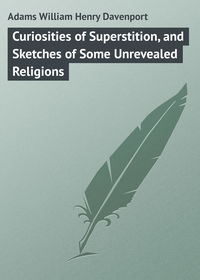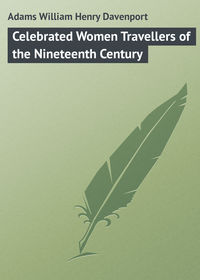 полная версия
полная версияWitch, Warlock, and Magician
Heydon advocated, without enforcing his precepts by example, the Rosicrucian dogma, that men could live without eating and drinking, affirming that all of us could exist in the same manner as the singular people dwelling near the source of the Ganges, described by his namesake, Sir Christopher Heydon39 (but certainly by no other traveller), who had no mouths, and therefore could not eat, but lived by the breath of their nostrils – except when they went on a far journey, and then, to recuperate their strength, they inhaled the scent of flowers. He dilated on the ‘fine foreign fatness’ which characterized really pure air – the air being impregnated with it by the sunbeams – and affirmed that it should suffice for the nourishment of the majority of mankind. He was not unwilling, however, that people with gross appetites should eat animal food, but declared it to be unnecessary for them, and that a much more efficacious mode would be to use the meat, nicely cooked, as a plaster on the pit of the stomach. By adopting this external treatment, they would incur no risk of introducing diseases, as they did by the broad and open gate of the mouth, as anyone might see by the example of drink; for so long as a man sat in water, he knew no thirst. He had been acquainted – so he declared – with many Rosicrucians who, by using wine as a bath, had fasted from solid food for several years. And, as a matter of fact, one might fast all one’s life, though prolonged for 300 years, if one ate no meat, and so avoided all risk of infection by disease.
Growing confidential in reference to his imaginary fraternity, he states that its chiefs always carried about with them their symbol, the R.C., an ebony cross, flourished and decked with roses of gold; the cross typifying Christ’s suffering for the sins of mankind, and the golden roses the glory and beauty of His Resurrection. This symbol was carried in succession to Mecca, Mount Calvary, Mount Sinai, Haran, and three other places, which I cannot pretend to identify – Casele, Apamia, and Chaulateau Viciosa Caunuch: these were the meeting-places of the brotherhood.
‘The Rosie Crucian Physick or Medicines,’ says this bravely-mendacious gentleman, ‘I happily and unexpectedly light upon in Arabia, which will prove a restoration of health to all that are afflicted with sickness which we ordinarily call natural, and all other diseases. These men have no small insight into the body: Walford, Williams, and others of the Fraternity now living, may bear up in the same likely equipage with those noble Divine Spirits their Predecessors; though the unskilfulness in men commonly acknowledges more of supernatural assistance in hot, unsettled fancies, and perplexed melancholy, than in the calm and distinct use of reason; yet, for mine own part, I look upon these Rosie Crucians above all men truly inspired, and more than any that professed themselves so this sixteen hundred years, and I am ravished with admiration of their miracles and transcendant mechanical inventions, for the solving the Phænomenon of the world. I may, without offence, therefore, compare them with Bezaliel, Aholiab, those skilful workers of the Tabernacle, who, as Moses testifies, were filled with the Spirit of God, and therefore were of an excellent understanding to find out all manner of curious work.’
The plain fact is that Heydon’s books are fictions– purely imaginative work, based on some rough and ready knowledge of the old alchemy and the new magic; partly allegorical and mystical, such as a quick invention might readily conceive under the influence of theosophic study, and partly borrowed from Henry More, and other writers of the same stamp. The island inhabited by Rosicrucians, which he describes in the introduction to ‘The Holy Guide,’ was evidently suggested by Sir Thomas More’s ‘Utopia,’ and Bacon’s ‘New Atlantis.’ It would be easy to point out his obligations elsewhere.
I may add, in bringing this chapter to a close, that Dr. Edmund Dickenson, one of Charles II.’s physicians, professed to be a member of the brotherhood, and wrote a book upon one of their supposed doctrines, entitled ‘De Quinta Essentia Philosophorum,’ which was printed at Oxford in 1686.
Whatever may be our opinion of Rosicrucianism, which, I believe, still finds some believers and adepts in this country, we must acknowledge that the literature of poetry and fiction is indebted to it considerably. The machinery of Pope’s exquisite poem, ‘The Rape of the Lock,’ was borrowed from Paracelsus and Jacob Böhmen – not directly, it is true, but through the medium of the Abbé de Villars’ sparkling romance, ‘Le Comte de Gabalis.’ ‘According to those gentlemen,’ says Pope, ‘the four elements are inhabited by spirits, which they call sylphs, gnomes, nymphs, and salamanders.’
The Rosicrucian water-nymph supplied La Motte Fouqué with the idea of that graceful and lovely creation, ‘Undine,’ and Sir Walter Scott has invested his ‘White Lady of Avenel’ with some of her attributes.
William Godwin’s romance of ‘St. Leon’ turns on the Rosicrucian fancy of immortal life; while Lord Lytton’s ‘Zanoni’ is practically a Rosicrucian fiction. The influence of the Rosicrucian writers is also apparent in the same author’s ‘A Strange Story.’
BOOK II
WITCHES AND WITCHCRAFT
CHAPTER I
EARLY HISTORY OF WITCHCRAFT IN ENGLAND
To various conspicuous and easily intelligible causes the witch and the warlock, like the necromancer and the astrologer, owed their power with the multitude. First, there was the eager desire which humanity not unnaturally feels to tear aside the veil of Isis, and obtain some knowledge of that Other World which is hidden so completely from it. Next must be taken into account man’s greed for temporal advantages, his anxiety to direct the course of events to his personal benefit; and, lastly, his malice against his fellows. Thus we see that the influence enjoyed by the sorcerer and the magician had its origin in the unlawful passions of humanity, in whose history the pages that treat of witches and witchcraft are painful and humiliating reading.
To define the limit between the special functions of the magician and the witch is somewhat difficult, more especially as the position of the witch gradually decreased in reputation and importance. There is a great gulf between the witch of Endor, or the witch of classical antiquity, or the witch of the Norse Sagas, or the witch of the Saxons, and the English or Scottish witch of the sixteenth and seventeenth centuries. The former were surrounded with an atmosphere of dread and mystery; the latter was the creature of vulgar and commonplace traditions. In the early age of witchcraft, the witch, like the magician, summoned spirits from the vasty deep, discovered the hiding-places of concealed treasures, struck down men or beasts by her spells, or covered the heavens with clouds and let loose the winds of destruction and desolation. Both could blight the promise of the harvest, baffle the plans of their enemies, or wither the health of their victims. But while the magician was frequently a man of ability and learning, and belonged to the cultured classes, the witch was almost always a woman of the lower orders, ignorant and uneducated, though occasionally ladies of high rank, and even ecclesiastics, have been accused of practising witchcraft.
While witchcraft was a power in the land, the witch, or warlock, was popularly supposed to be the direct instrument, and, indeed, the bond-slave, of the Evil One, fulfilling his behests in virtue of a compact, written in letters of blood, by which the witch made over her soul to the Infernal Power in return for the enjoyment of supernatural prerogatives for a fixed period. This treaty having been concluded, the witch received a mark on some part of the body, which was thenceforward insensible of pain – the stigma or devil’s mark, by which he might know his own again. A familiar imp or spirit was assigned to her, generally in the form of an animal, and more particularly in that of a black cat or dog. Round this general idea were gathered a number of horrible and unclean conceptions, on which, happily, it will not be necessary to enlarge. The devil, it was said, resorted to carnal communication with his servants, being denominated succubus when the favourite was a female, and incubus when a male was chosen. It was alleged, too, that on certain occasions the devil, with his familiars, and the great company of witches and warlocks whose souls he had bought, assembled in the dead of night in some remote and savage wilderness, to hold that frightful carnival of the Witches’ Sabbat which Goethe has depicted so powerfully in the second part of ‘Faust.’ The human imagination has not invented, I think, any scene more horrible, more degrading, or more bestial. We may suppose, however, that it was not conceived by any single mind, or even people, or in any single generation, but that it gradually took up additional details from different nations, at different times, until it was developed into the terrible whole presented by the mediæval writers.
This wild and awful revel was called the Sabbat because it took place after midnight on Friday; that is, on the Jewish Sabbath – a curious illustration of the popular antipathy against the Jews.
The spot where it was held never bloomed again with flower or herb; the burning feet of the demons blighted it for ever.
Witch or warlock who failed to obey the summons of the master was lashed by devils with rods made of scorpions or serpents, in chastisement of his or her contumacy.
The guests repaired thither, according to the belief entertained in France and England, upon broomsticks; but in Spain and Italy it was thought that the devil himself, in the shape of a goat, conveyed them on his back, which he contracted or elongated according to the number he carried. The witch, when starting on her aerial journey, would not quit her house by door or window; but astride on her broomstick made her exit by the chimney. During her absence, to prevent the suspicions of her neighbours from being aroused, an inferior demon assumed the semblance of her person, and lay in her bed, pretending to be ill or asleep.
A curious story may here be introduced. In April, 1611, a Provençal curé, named Gaurifidi, was accused of sorcery before the Parliament of Aix. In the course of trial much was said in proof of the power of the demons. Several witnesses asserted that Gaurifidi, after rubbing himself with a magic oil, repaired to the Sabbat, and afterwards returned to his chamber down the chimney. One day, when this sort of thing was exciting the imagination of the judges, an extraordinary noise was heard in the chimney of the hall, terminating suddenly in the apparition of a tall black man, who shook his head vigorously. The judges, thinking the devil had come in person to the rescue of his servant, took to their heels, with the exception of one Thorm, the reporter, who was so hemmed in by his desk that he was unable to move. Terror-stricken at the sight before him, with his body all of a tremble, and his eyes starting from his head, he made repeated signs of the cross, until the supposed fiend was equally alarmed, since he could not understand the cause of the reporter’s evident perturbation. On recovering from his embarrassment he made himself known – he was a sweep, who had been operating on a chimney on the roof above, but, when ready to return, had mistaken the entrance, and thus unwillingly intruded himself into the chamber of the Parliament.
The unclean ceremonies of the Witches’ Sabbat were ‘inaugurated’ by Satan, who, in his favourite assumption of a huge he-goat (a suggestion, no doubt, from Biblical imagery), with one face in front, and another between his haunches, took his place upon his throne. After all present had done homage by kissing him on the posterior face, he appointed a master of the ceremonies, and, attended by him, made a personal examination of any guest to ascertain if he or she bore the stigma, which indicated his right of ownership. Any who were found without it received the mark at once from the master of the ceremonies, while the devil bestowed on them a nickname. Thereafter all began to dance and sing with wild extravagance —
‘There is no rest to-night for anyone:When one dance ends another is begun’ —until some neophyte arrived, and sought admission into the circle of the initiated. Silence prevailed while the newcomer went through the usual form of denying her salvation, spitting upon the Bible, kissing the devil, and swearing obedience to him in all things. The dancing then renewed its fury, and a hoarse chorus went up of —
‘Alegremos, alegremos,Que gente va tenemos!’When spent with the violent exercise, they sat down, and, like the witches in ‘Macbeth,’ related the evil things each had done since the last Sabbat, those who had not been sufficiently active being chastised by Satan himself until they were drenched in blood. A dance of toads was the next entertainment. They sprang up out of the earth by thousands, and danced on their hind-legs while Satan played on the bagpipes or the trumpet, after which they solicited the witches to reward them for their exertions by feeding them with the flesh of unbaptized babes. Was there ever a more curious mixture of the grotesque and the horrible? At a stamp from the devil’s foot they returned to the earth whence they came, and a banquet was served up, the nature of which the reader may be left to imagine! Dancing was afterwards resumed, while those who had no partiality for the pastime found amusement in burlesquing the sacrament of baptism, the toads being again summoned and sprinkled with holy water, while the devil made the sign of the cross, and the witches cried out in chorus: ‘In nomine Patricâ, Aragueaco Patrica, agora, agora! Valentia, jurando gome guito goustia!’ that is, ‘In the name of Patrick, Patrick of Aragon now, now, all our ills are over!’
Sometimes the devil would cause the witches to strip themselves, and dance before him in their nakedness, each with a cat tied round her neck, and another suspended from her body like a tail. At cockcrow the whole phantasmagoria vanished.
One cannot help wondering who first conceived the idea of these horrid saturnalia. Did it spring from the diseased imagination of some half-mad monk, brooding in the solitude of his silent cell, who gathered up all these unclean and grim images and worked them into so ghastly a picture? They are partly heathen, partly Christian; partly classical, partly Teutonic – a strange and unwholesome compound, as ‘thick and slab’ as the hell-broth mixed by the hags on ‘the blasted heath’!
In these pages I am concerned only with our own ‘tight little island,’ into which the superstition was most certainly introduced by the northern invaders. It would derive strength and consistency from the teaching of the Old Testament, which distinctly recognises the existence of witchcraft. ‘Let not a witch live!’ is the command given in Exodus (chapter xxii.); and similar threats against witches, wizards and the like frequently occur in the books of Leviticus and Deuteronomy. Says Sir William Blackstone: ‘To deny the possibility, nay, the actual existence of witchcraft and sorcery, is at once flatly to contradict the revealed Word of God in various passages of the Old and New Testaments, and the thing itself is a truth to which every nation in the world hath, in its turn, borne testimony, either by example seemingly well attested, or by prohibitory laws, which at least suppose the possibility of a commerce with evil spirits.’ The Church at a very early period admitted its existence, and fulminated against all who practised it. The fourth canon of the Council of Auxerre, in 525, stringently prohibited all resort to sorcerers, diviners, augurs, and the like. A canon of the Council held at Berkhampstead in 696 condemned to corporal punishment, or mulcted in a fine, every person who made sacrifices to the evil spirits. Under the name of sortilegium, the offence was treated eventually as a kind of heresy, for which, on the first occasion, the offender, if penitent, was punished by the Ecclesiastical Courts; but if there were no abjuration, or a relapse after abjuration, she was handed over to the secular power to be executed by authority of the writ de heretico comburendo. At a later date, statutes against witchcraft were enacted by Parliament, and the offence was both tried and punished by the civil power. Such statutes were passed in the reigns of Henry VIII., Elizabeth, and James I. Legislation derives its chief support from public opinion; and these statutes are a proof that the existence of witchcraft was generally believed in. ‘For centuries in this country,’ says Mr. Inderwick, ‘strange as it may now appear, a denial of the existence of such demoniacal agency was deemed equal to a confession of atheism, and to a disbelief in the Holy Scriptures themselves. Not only did Lord Chancellors, Lord Keepers, benches of Bishops, and Parliament after Parliament attest the truth and the existence of witchcraft, but Addison, writing as late as 1711, in the pages of the Spectator, after describing himself as hardly pressed by the arguments on both sides of this question, expresses his own belief that there is, and has been, witchcraft in the land.’ At the same time, it is pleasant to remember that there have almost always been a few minds, bolder and more enlightened than the rest, to protest against a credulity which led to acts of the greatest inhumanity, and fostered a grotesque and dangerous superstition.
It is in the twelfth century that we first obtain, in England, any distinct indications of the nature of this superstition, and it is then we first meet with the written compact between the devil and his victim. The story of the old woman of Berkeley, with which Southey’s ballad has made everybody familiar, is related by William of Malmesbury, on the authority of a friend who professed to have been an eye-witness of the facts. When the devil, we read, announced to the witch that the term of her compact had nearly expired, she summoned to her presence the monks of the neighbouring monastery and her children, confessed her sins, acknowledged her criminal compact, and displayed a curious anxiety lest Satan should secure her body as well as her soul. ‘Sew me in a stag’s hide,’ she said, ‘and, placing me in a stone coffin, shut me in with lead and iron. Load this with a heavy stone, and fasten down the whole with three iron chains. Let fifty psalms be sung by night, and fifty masses be said by day, to baffle the power of the demons, and if you can thus protect my body for three nights, on the fourth day you may safely bury it in the ground.’ These precautions, though religiously observed, proved ineffectual. On the first night the monks bravely resisted the efforts of the fiends, who, however, on the second night, renewed the attack with increased vehemence, burst open the gates of the monastery, and rent asunder two of the chains which held down the coffin. On the third night, so terrible was the hurly-burly, that the monastery shook to its foundations, and the terror-stricken priests paused, aghast, in the midst of their ministrations. Then the doors flew apart, and into the sacred place stalked a demon, who rose head and shoulders above his fellows. Stopping at the coffin, he, in a terrible voice, commanded the dead to rise. The woman answered that she was bound by the third chain: whereupon the demon put his foot on the coffin, the chain snapped like a thread, the coffin-lid fell off, the witch arose, and was hurried to the church-door, where the demon, mounting a huge black horse, swung his victim on to the crupper, and galloped away into the darkness with the swiftness of an arrow, while her shrieks resounded through the air.
There are many allusions in the old monastic chronicles which illustrate the development of public opinion in reference to witches and their craft. Thus, John of Salisbury describes the nocturnal assemblies of the witches, the presence of Satan, the banquet, and the punishment or reward of the guests according to the failure or abundance of their zeal. William of Malmesbury tells us that on the highroad to Rome dwelt a couple of beldams, of ill repute, who enticed the weary traveller into their wretched hovel, and by their incantations transformed him into a horse, a dog, or some other animal – similar to the transformations we read of in Oriental tales – and that this animal they sold to the first comer, in this way picking up a tolerable livelihood. One day, a jongleur, or mountebank, asked for a night’s lodging, and when he disclosed his vocation to the two hags, they informed him that they had an ass of remarkable capacity, which, indeed, could do everything but speak, and that they were willing to sell it. The sum asked was large, but the ass displayed such wonderful intelligence that the jongleur gladly paid it, and departed, taking with him the ass and a piece of advice from the old women – not to let the ass go near running water. For some time all went well, the ass became an immense attraction, and the jongleur was growing passing rich, when, in one of his drunken fits, he allowed the animal to escape. Running directly to the nearest stream, it plunged in, and immediately resumed its original shape as a handsome young man, who explained that he had been transformed by the spells of the two crones.
The first trial for witchcraft in England occurred in the tenth year of King John, when, as recorded in the ‘Abbreviatio Placitorum,’ Agnes, wife of Ado the merchant, accused one Gideon of the crime; but he proved his innocence by the ordeal of red-hot iron. The first trial which has been reported with any degree of particularity belongs to the year 1324. Some citizens of Coventry, it would appear, had suffered severely at the hands of the prior, who had been supported in his exactions by the two Despensers, Edward II.’s unworthy favourites. In revenge, they plotted the death of the prior, the favourites, and the King. For this purpose they sought the assistance of a famous magician of Coventry, named Master John of Nottingham, and his man, Robert Marshall of Leicester. The conspiracy was revealed by the said Robert Marshall, probably because his pecuniary reward was unsatisfactory, and he averred that John of Nottingham and himself, having agreed to carry out the desire of the citizens, the latter, on Sunday, March 13, brought an instalment of the stipulated fee, together with seven pounds of wax and two yards of canvas; that with this wax he and his master made seven images, representing respectively the King (with his crown), the two Despensers, the prior, his caterer, and his steward, and one Richard de Lowe – the last named being introduced merely as a lay-figure on which to test the efficacy of the charm.
The two wizards retired to an old ruined house at Shorteley Park, about half a league from Coventry, where they remained at work for several days, and about midnight on the Friday following Holy Cross Day, the said Master John gave to the said Robert a sharp-pointed leaden branch, and commanded him to insert it about two inches deep in the forehead of the image representing Richard de Lowe, this being intended as an experiment. It was done, and next morning Master John sent his servant to Lowe’s house to inquire after his condition, who found him screaming and crying ‘Harrow!’ He had lost his memory, and knew no one, and in this state he continued until dawn on the Sunday before Ascension, when Master John withdrew the branch from the forehead of the image and thrust it into the heart. There it remained until the following Wednesday, when the unfortunate man expired. Such was Robert Marshall’s fable, as told before the judges; but apparently it met with little credence, and the trial, after several adjournments, fell to the ground.
Wonderful stories are told by the later chroniclers of a certain Eudo de Stella, who had acquired great notoriety as a sorcerer. William of Newbury says that his ‘diabolical charms’ collected a large company of disciples, whom he carried with him from place to place, adding to their number wherever he stopped. At times he encamped in the heart of a wood, where sumptuous tables were suddenly spread with all kinds of dainty dishes and fragrant wines, and every wish breathed by the meanest guest was immediately fulfilled. Some of Eudo’s followers, however, confided to our authority that there was a strange want of solidity in these magically-supplied viands, and that though they ate of them continually, they were never satisfied. But it appears that whoever once tasted of the sorcerer’s meats, or received from him a gift, thereby became enrolled among his followers. And the chronicler supplies this irrefutable proof: A knight of his acquaintance paid a visit to the wizard, and endeavoured to turn him from his evil practices. When he departed, Eudo presented his squire with a handsome hawk, which the knight, observing, advised him to cast away. Not so the squire: he rejoiced in his high-mettled bird; but they had scarcely got out of sight of the wizard’s camp before the hawk’s talons gripped him more and more closely, and at last it flew away with him, and he was never more heard of.





